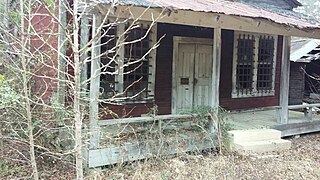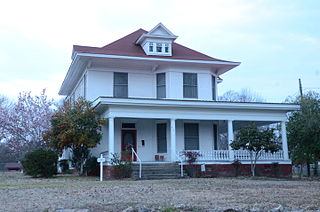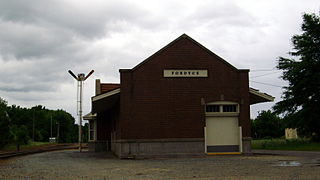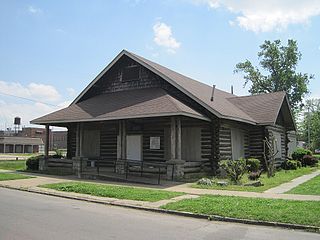
The Wynne House is a historic house on 4th Street in Fordyce, Arkansas. The two story wood frame house was built in 1914, and is the city's best example of residential Classical Revival architecture. It is Foursquare in plan, with a hip roof with large gable dormers projecting. A porch wraps around two sides, featuring elaborate spindled balusters and Ionic columns.

The First Universalist Society of West Sumner is a historic church at 1114 Main Street in Sumner, Maine. Built in 1867, this small Italianate church is one of the least-altered period churches of rural Maine. Notably, neither electricity nor modern heating have been added to the sanctuary, and the only major modification to the building was the 1913 addition of a kitchen space to the rear of its basement level. The building was listed on the National Register of Historic Places in 2002.

Prosperity Baptist Church is a historic church on Arkansas Highway 8 West in the rural community of Ramsey, Arkansas, located in central Dallas County. The single-story Plain Traditional wood frame church was built in 1904, with a major addition in 1945 giving it its present T shape. It is a gable roof structure resting on a foundation of concrete piers and petrified wood. The church was built on land purchased from the Fordyce Lumber Company by a congregation organized in 1902. It is the only surviving building from Ramsey's early days.

The Bluff Springs Church and School is a historic dual-purpose building in rural northwestern Stone County, Arkansas. It is located west of Onia, near the junction of county roads 136 and 140. It is a rectangular box-constructed structure, topped by a gable roof with a small belfry on top. It is covered with weatherboard siding and rests on stone foundation. The south-facing front has a pair of entrances, symmetrically placed, and there is a shed-roof addition to the north end. Built in 1900, it is one of the oldest school buildings in the county.

The Yell County Courthouse is a courthouse in Dardanelle, Arkansas, United States, one of two county seats of Yell County, built in 1914. It was listed on the National Register of Historic Places in 1992. The courthouse is the second building to serve the Dardanelle district of Yell County.

The Champ Grubbs House is a historic antebellum dog trot log cabin in rural Drew County, Arkansas. It is located on Ozment Bluff Road, west of Arkansas Highway 172 and southwest of the county seat of Monticello. The single story log structure is estimated to have been built in 1859, and is one of the few such surviving buildings in the county. It was originally built to a typical dogtrot plan, although separate shed roof rooms were added to its rear in the 19th century, though these were removed and replaced with a similar addition in the 1980s. The center of the dog trot has been enclosed, and is accessed via a door from the front. The eastern log bay also functions as an entry, while that on the west side has been converted to a window. In much of the interior the log finish has been covered by paneling.

The Holt–Poindexter Store Building is a historic retail building in rural Ouachita County, Arkansas. It is located on County Road 101, near its southern junction with County Road 111, about 4 miles (6.4 km) north of Stephens, in the unincorporated community of Ogemaw. The store, a vernacular single-story wood frame structure with a gable roof and full-width front porch, was built in 1904 by H. B. Holt, and is believed to be the oldest general store in southern Arkansas. A small addition was added to the north side in the 1920s to house post office facilities. This was removed in 1948, at which time a rear addition was added to provide space for an office and feed storage. The business was taken over by Holt's son-in-law, Chester Poindexter, and then his son, Kenneth.

The Butler-Matthews Homestead is a historic farm complex near the hamlet of Tulip in rural Dallas County, Arkansas. The property is historically significant for two reasons: the first is that it includes a collection of 15 farm-related buildings built between the 1850s and the 1920s, and it is the location of one of Dallas County's two surviving I-houses.

The Dallas County Training School High School Building is a historic school building at 934 Center Street in Fordyce, Arkansas. Built in 1934 with funding from the Rosenwald Fund, it was the only high school serving African Americans in a four-county region of southern Arkansas until 1940. Its original block is a rectangular brick structure with a gable-on-hip roof; a flat-roof addition was made to the rear in 1954. The building house grades 6-12 of African Americans until 1970, when the city's schools were integrated. At that time it became an elementary school, and was finally closed in 2001.

The Elliott House is a historic house at 309 Pine Street in Fordyce, Arkansas. The 1-1/2 story wood frame house was built in 1925, and is a well-executed example of Craftsman style. It is a rectangular structure with three overlapping gabled roof sections with different pitches. The eaves are wide, and decorated with knee braces and exposed purlins. A fourth gable extends over the main entry, which has a twelve-light door with flanking sidelight windows.

The Fordyce Commercial Historic District encompasses the historic heart of Fordyce, Arkansas, the county seat of Dallas County. It encompasses four city blocks of North Main Street, between 1st and 4th, and includes properties on these adjacent streets. Fordyce was founded in 1882, and the oldest building in the district, the Nutt-Trussell Building at 202 North Main Street, was built c. 1884. Spurred by the logging industry and the Cotton Belt Railroad, Fordyce's downtown area had 25 buildings by 1901, and continued to grow over the next few decades, resulting in a concentration of period commercial architecture in its downtown. The district was listed on the National Register of Historic Places in 2008.

The Nutt–Trussell Building is a historic commercial building at 202 North Main Street in downtown Fordyce, Arkansas, USA. Built in 1883, this two-story structure was the first brick building erected in Fordyce, a railroad town in southwestern Arkansas. Its exterior was covered in stucco c. 1920. It was built by Robert Nutt, who operated a dry goods shop on the premises. It later housed the Bank of Fordyce, and its upper floor has a long history of use for social club meetings, and also housed the city's first telephone exchange. The descendants of L. L. Trussell, a later owner, gave the building to the city in 2000 for use as a local history museum.

The Waters House is a historic house at 515 Oak Street in Fordyce, Arkansas. The 2-1/2 story Foursquare house was designed by Charles L. Thompson and built in 1907, and is one of the finest Colonial Revival houses in the city. It has a hipped roof with flared eaves, and cross gables on the sides. The main facade features a projecting bay that rises the full two stories, and is topped by a gable with dentil molding and flared eaves. A single-story porch wraps around two sides of the house.

The Rock Island Railway Depot is a historic train station building on 3rd Street in Fordyce, Arkansas. Built c. 1925 by the Rock Island Railroad, it is one of two brick railroad stations to survive from the period in Dallas County. It is a large rectangular structure with a cross-gable tile roof. The building continues to be used by the Fordyce and Princeton Railroad to manage the shipment of lumber products.

The John Russell House is a historic house at 904 Charlotte Street in Fordyce, Arkansas. This single-story wood frame house was built c. 1925, and is Dallas County's finest example of Craftsman architecture. It has an outstanding porch whose roof is supported by four columns of geometrically arranged wooden members. A horizontal tie beam between the inner columns supports a column up to the apex of the gable roof.

The Richard L. Kitchens Post No. 41 is a historic American Legion hall at 409 Porter Street in Helena, Arkansas. Built in 1922 to a design by a local Legionnaire, this Rustic log structure is supposedly the first American Legion hall to be referred to as a "hut", and is the oldest Legion building in the city. Its main block is built of donated materials, including the cypress logs forming its walls, and built by volunteer labor supervised by a local contractor and Legionnaire. A frame addition was added to the rear of the building in 1949, as were two shed-roof additions.

The Rice-Upshaw House is a historic house in rural Randolph County, Arkansas. It is located on the west side of Arkansas Highway 93, about 2 miles (3.2 km) south of Dalton, just north of where the highway crosses Upshaw Creek. Built c. 1826, this log structure is one of the oldest buildings in the state of Arkansas, and one of a handful that predate its statehood. It is 1-1/2 stories in height, with a hall and parlor plan. The exterior is clad in shiplap siding. The walls are constructed of rough-hewn logs, from a variety of wood species, that are fitted together with half dovetails. A fieldstone chimney rises on the east side of the house. The building underwent some alterations c. 1920, including the addition of a corrugated metal roof, and windows on either side of the chimney. A porch extending on the north side of the building was then closed in, to provide for a bathroom and kitchen. A second porch, on the south side, has also been enclosed.

The Binks Hess House and Barn are a historic farm property in Marcella, Arkansas. Located just east of Arkansas Highway 14 on Partee Drive, it is a 1-1/2 story dogtrot house, with a side gable roof, weatherboard siding, and a stone pier foundation. A single-story porch, supported by square posts, stands in front of the open breezeway section, which is finished in flushboarding, at the center of the east-facing main facade. An ell extends to the rear. Behind the house stands the barn, built on a transverse crib plan with side shed-roof additions. Both house and barn were built about 1871 for Binks Hess, brother of Marcella's founder Thomas. The barn is believed to be the oldest in Stone County, and the first to use sawn lumber in its construction.

The Joe Emmer House was a historic house in rural northern White County, Arkansas. It was located on County Road 47, northwest of the Holly Springs Church. It was a single-story single-pen log structure, with a side gable roof and a shed-roof porch across the front. The logs were hand-hewn and joined by dovetailed notches. A frame addition extended the building to the west. The house was built c. 1890, and was one of about thirty such houses remaining in the county.

The E.D. Maddox Farm Chicken House is a historic farm outbuilding at the northwest corner of Arkansas Highway 36 and School Street in Rosebud, Arkansas. It is a single-story rectangular structure, with a side gable roof and a concrete foundation. A shed-roof porch extends across the front, with the main entrance to the structure set off-center underneath. The south (street-facing) facade presents a distinctive diagonally-sided exterior, a reflection of the building's interior construction, which is entirely of diagonally cut framing elements. Built in 1938, it is the only known structure with this type of construction in White County.



















